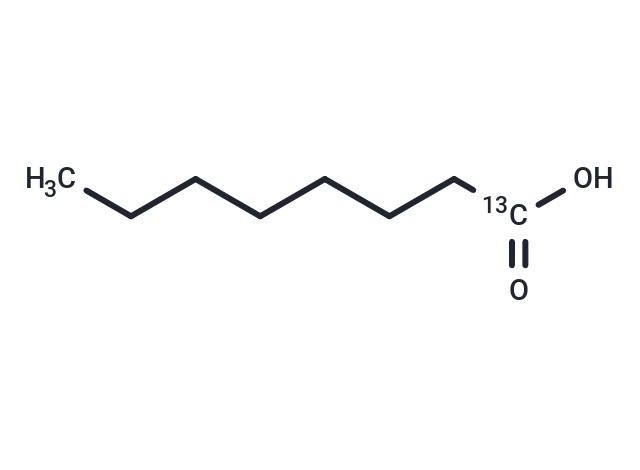 Your shopping cart is currently empty
Your shopping cart is currently empty

Octanoic acid-13C is intended for use as an internal standard for the quantification of octanoic acid by GC- or LC-MS. Octanoic acid is a medium-chain saturated fatty acid. It has been found in Teleme cheeses made from goat, ovine, or bovine milk.1 Octanoic acid is active against the bacteria S. mutans, S. gordonii, F. nucleatum, and P. gingivalis (IC80s = <125, <125, 1,403, and 2,294 μM, respectively).2 Levels of octanoic acid are increased in the plasma of patients with medium-chain acyl-CoA dehydrogenase (MCAD) deficiency, an inborn error of fatty acid metabolism characterized by hypoketotic hypoglycemia, medium-chain dicarboxylic aciduria, and intolerance to fasting.3,4

| Pack Size | Price | USA Warehouse | Global Warehouse | Quantity |
|---|---|---|---|---|
| 250 mg | $118 | 35 days | 35 days |
| Description | Octanoic acid-13C is intended for use as an internal standard for the quantification of octanoic acid by GC- or LC-MS. Octanoic acid is a medium-chain saturated fatty acid. It has been found in Teleme cheeses made from goat, ovine, or bovine milk.1 Octanoic acid is active against the bacteria S. mutans, S. gordonii, F. nucleatum, and P. gingivalis (IC80s = <125, <125, 1,403, and 2,294 μM, respectively).2 Levels of octanoic acid are increased in the plasma of patients with medium-chain acyl-CoA dehydrogenase (MCAD) deficiency, an inborn error of fatty acid metabolism characterized by hypoketotic hypoglycemia, medium-chain dicarboxylic aciduria, and intolerance to fasting.3,4 |
| Molecular Weight | 145.2 |
| Formula | C8H16O2 |
| Cas No. | 59669-16-8 |
| Smiles | C(CCCCC)C[13C](O)=O |
| Storage | Powder: -20°C for 3 years | In solvent: -80°C for 1 year | Shipping with blue ice/Shipping at ambient temperature. | |||||||||||||||||||||||||||||||||||
| Solubility Information | Ethanol: 30 mg/mL (206.61 mM), Sonication is recommended. DMF: 30 mg/mL (206.61 mM), Sonication is recommended. DMSO: 30 mg/mL (206.61 mM), Sonication is recommended. | |||||||||||||||||||||||||||||||||||
Solution Preparation Table | ||||||||||||||||||||||||||||||||||||
Ethanol/DMF/DMSO
| ||||||||||||||||||||||||||||||||||||
| Size | Quantity | Unit Price | Amount | Operation |
|---|

Copyright © 2015-2026 TargetMol Chemicals Inc. All Rights Reserved.